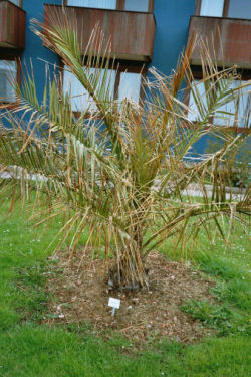
Outplantations And Inspection Spring 2005
In 2005 there were new outplantations of us on Heligoland and we made an inspection round simultaneously which also brought us a set of important new knowledge, too. We also had to experience surprises, both positive and negative.
We could get more than 200 plants which partly also came from donators this time together. At first the plants got stored at me different from 2004 where they could be provided better and also protected from possible late frosts. Joerg Witticke could take totally 71 plants to the Heligolandian freight office with his supporter to Cuxhaven. Also this time there were 2 bigger palms, a 7 feet tall Phoenix canariensis and an about 5 feet tall Syagrus romanzoffiana.
Also this time there are bamboos (5 specimens of Pseudosasa japonica) and also 5 rhizomes of Arundo donax directly from Reinhard Trautmann at the plant market at Kiekeberg. Matthias Hund, Chris Stuehrk and Wolfgang Henschel met themselves at the plant market because of this, the latter also had brought his donations, a Rhapis excelsa and a Nandina domestica.
Also a premiere represents a 2 feet tall Juania australis. Juania australis belows to the rarest palm species of the world. The Juania australis is resident on Juan Fernandez, an island in the South Pacific which belows to Chile, a very maritime species. First outplanting tests with this species in Ireland have proceeded successfully, it has survived 18 to 23°F there. It also would have an outdoor cultivation potential on Heligoland which we want to test therefore.
In the evening of April 27th, 2005 we drove to the airport Hamburg-Fuhlsbuettel to collect our Juania australis. Our Juania arrived by an airplane of Air France from Chile at 8.10 p. m. We received the import documents and went to the plant inspection place, the lady had a look at and said everything is all right and also stamped the documents. We then went to the custom to receive the Juania. After some discussions at the custom Matthias Hund could collect the Juania in the next morning and brought it to me on April 30th, it was then taken from him and me to the Hamburg jetties to the catamaran of the FRS, on Monday, May 2nd, addressed to Ulf Martens. It's now outplanted in an atrium of James Kruess School.
We went by the car from Joerg Witticke to Cuxhaven and handed in our plants at the Heligolandian freight office. We then went "Halunder jet" to the mooring of the catamaran and crossed over to Heligoland.
Arrived there, we passed by the hotel "Insulaner" and saw to the large Jubaea chilensis. It has survived the winter, the younger feather leaves still looked good, the older and outer feather leaves were drawn by salt wind damages. Then we went around the corner and saw two large Trachycarpus in big wood pails at one neighboring hotel. Joerg Witticke examined them, they also had the same leaf damages like the Jubaea. Joerg learned from the hotel owner that he had bought this trachys from Cordes. The two will come through just like the large Jubaea, their spears were still completely intact. Obviously the winter 2004/05 was exceptionally strong windy and stormily, there were exceptionally frequently storms. Ulf Martens has reported us that it was very windy and stormy throughout for once 2 weeks, that was itself for Heligoland very exceptionally. A harbinger of the climate change? It remained relatively mild till February, then a strong arctic cold air burglary came toward the end of February/March , the lowest temperature on Heligoland amounted to 25°F and in Hamburg at the airport Fuhlsbuettel 8°F.

Jubaea chilensis at the hotel "Insulaner" Spring
2005 with salt wind damages.
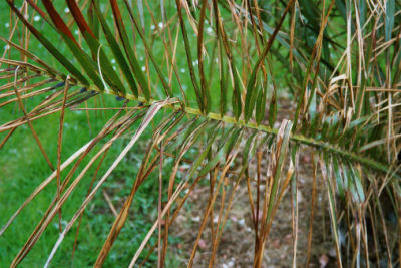
Salt wind damages at the feather leaf of the Jubaea chilensis.
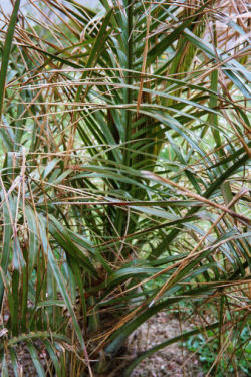
Good chances for one recovery still does the
Jubaea chilensis have, the youngest feather
leaves are still intact.
One cannot claim the damages would come from lacking frost or winter hardiness! Even Pinus nigra at the Biological Institution on the Northeast Area, Buxus sempervirens in different private gardens and many other ordinary garden plants had the same damages! Araucaria araucana, Phillreya latifolia, Hebe x franciscana and Euonymus japonica, they have as well as no leaf or needle damages show themself astonishingly sea salt wind resistance! These "exotics" are really absolutely salt wind fit!
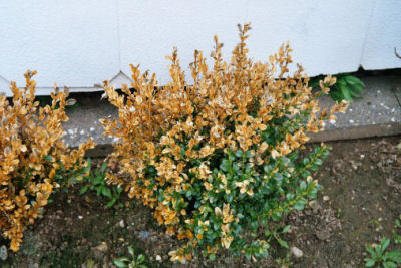
Buxus sempervirens with sea salt wind damages.
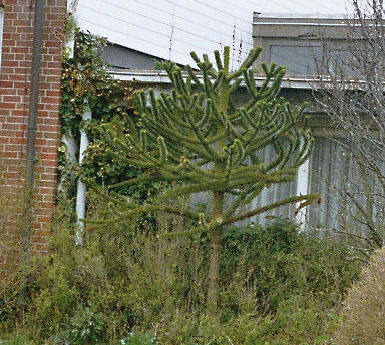
Araucaria araucana in the cure park on the Northeast Area absolutely
without sea salt wind damages in Spring 2005, one of the most sea
salt wind resistant conifers.
In 2006 or in 2007 young plants grown from seed from Araucaria angustifolia (Panana Pine, Brasil Pine) by me shall come onto the island and also prove their salt wind resistance and it also will show whether they are as sea salt wind resistant as Araucaria araucana. Araucaria angustifolia is hardy to 14°F, so might be hardy on Heligoland, but it's hardly outplantable on the German mainland.
The Cordyline australis also have come through the winter, but the tops of the leaves were damaged by strong sea salt winds, the brown tops of the leaves were frequently cut off. We went to the Upper Town by elevator and also could see the little garden of Ulf Martens, the small Cordyline australis var. atropurpurea from me in his garden has come through the winter but which the tops of the leaves were brown from the sea salt wind, the plant showed however new growth. Ulf also wants to plant a trachy from Brissago/Switzerland of Reto Gamma into his garden out. In his neighborhood stands also a Pseudosasa japonica of the family Ackermann. Our observations showed that the Pseudosasa japonica had much less leaf damages than Phyllostachys species for example that Pseudosasa japonica could be the best bamboo species for Heligoland and also for the coastal areas of Northern Germany.
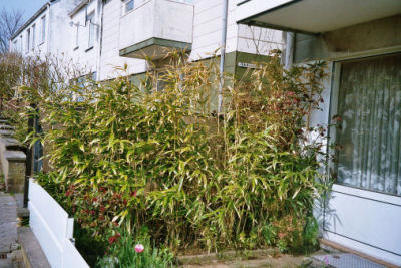
Pseudosasa japonica in the frontyard of the family Ackermann in spring, is
the best bamboo species for Heligloand!
On the school playground of James Kruess School on the planting island Pittosporum tobira has held out best, has proved to be relative salt wind resistant, therefore more should be planted on Heligoland. Against this Viburnum tinus has proved to be not salt wind tolerant. Quercus suber isn't particularly salt wind tolerant either, has lost the whole leaves, but it sprouts again.
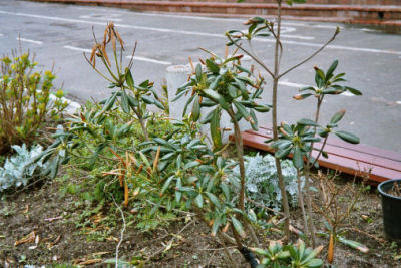
Pittosporum tobira on the planting island of the school playground of
James Kruess School in Spring 2005, has proved as relative salt wind
resistant!
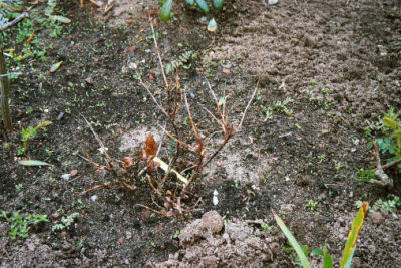
Viburnum tinus on the planting island of the school playground of
James Kruess School in Spring 2005, hasn't proved as sea salt wind
resistant!
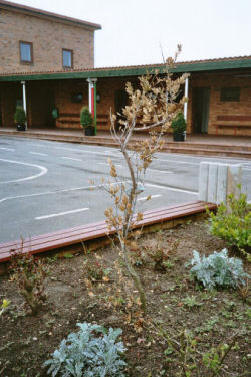
Quercus suber on the planting island of the
school playground of James Kruess School in
Spring 2005, dead loss of the foliage by sea
salt wind, but the tree sprouts again.
In the atria one of the two Callistemon citrinus has come through the winter with sea salt wind damages on the leaves, will sprout again. Cycas revoluta also has come through the winter with light sea salt wind damages. The palms also have come through the winter, primarily Chamaerops humilis has come through the winter well. The trachys have survived the winter, had heavy leaf damages by sea salt wind, not differently from most other trachys on Heligoland. Trachycarpus wagnerianus also has proved as less wind tolerant, has proved as not particular suitable for coastal plantations. Isn't wind toleranter than Trachycarpus fortunei. Ulf had bought a new larger Cordyline australis var. atropurpureum. But he doesn't want to plant this out, because the plant is too top-heavy and offers a too big target for the wind.
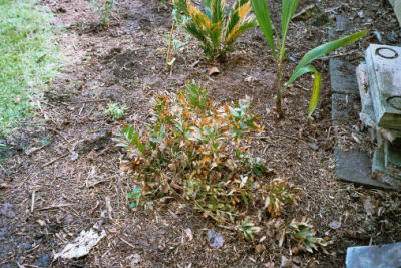
Callistemon citrinus with sea wind damages on the foliage in Spring 2005,
in the left behind of it Cycas revoluta and in the right the recently planted
Syagrus romanzoffiana.
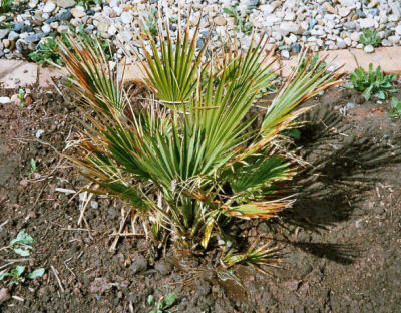
One of the Chamaerops humilis in the atria of James Kruess School in
Spring 2005.
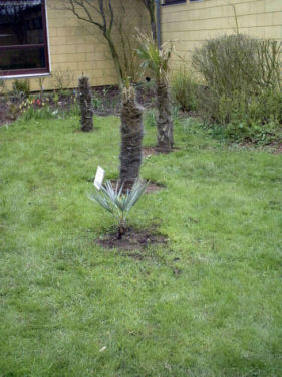
By sea salt wind damages drawn Trachycarpus fortunei
and wagnerianus in one atrium of James Kruess
School in Spring 2005, the damaged fans were cutten
off, in the foreground the recently planted Brahea armata.
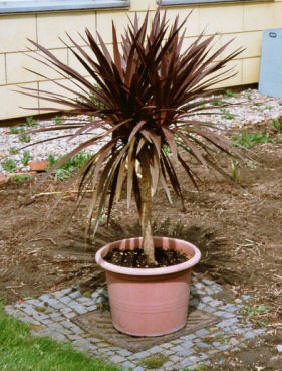
Cordyline australis var. atropurpureum in the pot in
Spring 2005, Ulf doesn't want to plant out however,
although it's really hardy on Heligoland. The reason
is the danger of the wind throw. You see that this plant
is too top-heavy.
Also the Poncirus hybrids didn't come through the winter so well, shoot top damages and total foliage loss, but they live. They are less sea salt wind tolerant than assumed. Also Citrus unshiu had heavy sea salt wind damages, therefore Joerg cut it back. Washingtonia filfera, Jubaea chilensis, Butia capitata and Phoenix canariensis also did come through the winter although but they have lost their leaves. Washingtonia robusta hasn't survived. They will hopefully regenerate over the summer again. But Ulf had reported on the telephone later that a 3 feet tall Washingtonia grown from seed shall did come through the winter at the electricity work on the Northeast Area well. By probably waste heat, if it is a Washingtonia robusta. We will look at this palm at the next time.
Eucalyptus gunnii and niphophila also seem strongly damaged, but they sprout possibly again, the sea salt wind was too strong. But we will test different species of eucalyptus, perhaps there are some sea salt wind tolerant species. Cinnamomum japonica has lost its whole leaves, but the wood is still good, could sprout again. Araucaria heterophylla had brown needlepoints, but it sprouts again. On the other hand, Araucaria araucana and angustifolia should be very well for Heligoland and for the coastal areas of Northern Germany.
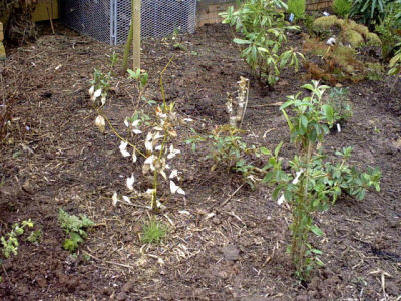
Cinnamomum japonica with sea salt wind damages in the left and in the
right the recently planted Ceanothus 'Gloire de Versailles'.
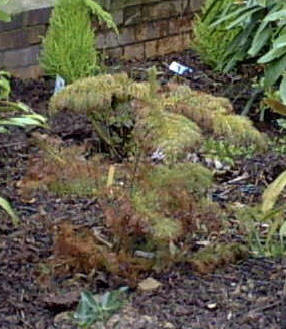
Araucaria heterophylla has survived 25°F in the winter
2004/05, only needle brownings!
The Agave americana also is still at the life, but it has leaf damages and will sprout again, its spear is still firm and OK. All the species of Phyllostachys have lost their leaves but they might recover again. Many of these species had lost their leaves also on the mainland, by the exceptionally strong cold snap at the end February/at the beginning of March 2005. But on Heligoland the strong sea salt wind has been responsibly for the total leaf loss of the species of Phyllostachys.
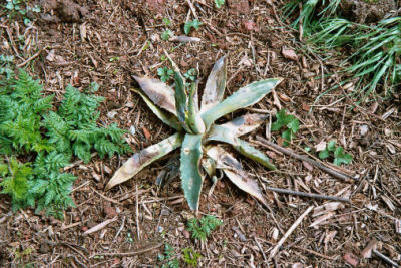
Agave americana in one atrium of James Kruess School in Spring 2005.
Phormium tenax has proved as perfect suitable for Heligoland, hardly damages! However Musa basjoo and thomsonii are completely rotten down to the ground. Whether they will resprout from the rhizomes again? Perhaps they need winter protection on Heligoland primarily against cold sea salt winds anyway. Such a winter protection should be constructed very stormproof, however. Cupressus cashmeriana also probably hasn't survived the winter, hasn't proved as sea salt wind resistant although actually hardy on Heligoland. Also Cupressus macrocarpa 'Goldcrest' had wind damages. Also Laurus nobilis of Ulf had leaf damages but it isn't the only specimen of this species which had this problem. But this one in pots at the hotel "Insulaner" and also the old one at the Mielck House. Nerium oleander also has survived the winter but most speicmens on Heligoland have lost their whole leaves and have even shoot top damages. Only at well protected places they have much less leaf damages. The oleander of Tim Pyschny under a tree in front of the house "Witte Kliff" in the Lower Town also looks better.
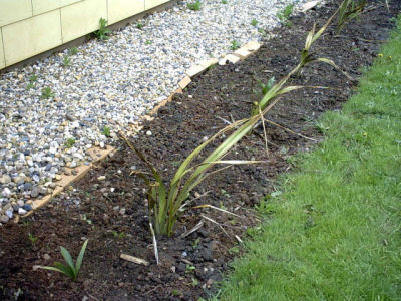
Phormium tenax in Spring 2005, nearly undamaged, has future on Heligoland!
We were surprised that Joerg's Aloe striatula has come through the winter well. The older leaves had got black and will decrease. But the younger leaves are still all right and the whole wood also, the aloe will sprout and regenerate again.
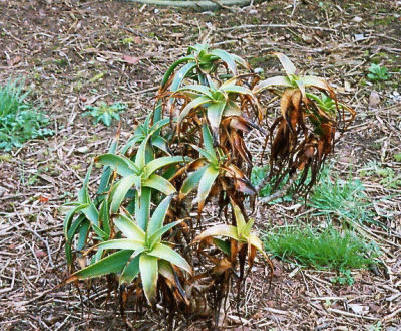
A surprise! Aloe striatula has even survived 25°F on Heligoland!
When we had finished with controls, we have started with the new outplantations. The outplantations of this year have confined themselves to James Kruess School. Opuntias, other cactuses, agaves, Yucca rostrata and aloes were planted out. I planted also differently colored Phormium varieties. Also I planted two small Metrosideros excelsa, this New Zealandian iron wood tree species shall be sea salt wind resistant. Whether it comes through the winter 2005/06 undamaged? It isn't hardy on the German mainland. I also have planted several different species of Callistemon out.
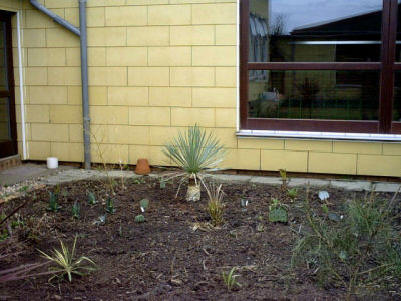
The new cactus bed with Yucca rostrata, agaves and aloes in Spring
2005, in the right closed to Yucca rostrata one by sea salt wind defoliated
Phoenix canariensis, which however will survive.
The next day the bigger plants arrived by freighter and Ulf picked up them. So that we could complete our outplantations for the year 2005. I planted a larger Pittosporum ralphii, a promising candidate for Heligoland, since we are of the opinion that the New Zealandians are well suitable for Heligoland and for the mildest parts of the coastal area of Northern Germany. Also Dicksonia antarctica, two Cyathea dregei and two Musa basjoo I planted under a tree in a corner sheltered from the wind.
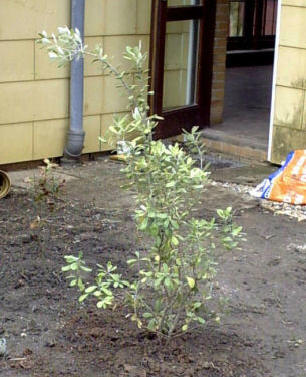
Recently planted Pittosporum ralphii in one atrium of
James Kruess Schoos in Spring 2005.
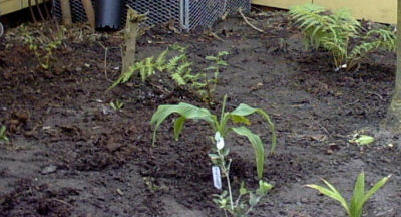
Recently planted Cyathea dregei, Dicksonia antarctica, Musa basjoo and
in the front of them one small Metrosideros excelsa wind sheltered under
one tree.
We also planted a 7 feet tall Phoenix canariensis, a about 5 feet tall Syagrus romanzoffiana, two Rhapis excelsa, three different varieties of Choisya ternata, two Brahea armata, a larger Metrosideros excelsa, a Fortunella japonica, Tamarix parviflora, Pseudosasa japonica, an Aloe broomii, one a little larger Olea europaea and a number of other "exotics". We then also have planted five Arundo donax and a Dahlia excelsa (tree dahlia) on the embankment between stairs and gymnasium at the school playground out. We also planted a Pseudosasa japonica at one wall at the school playground. After this we have planted innumerable small two year old Trachycarpus fortunei and Chamaerops humilis on different places as sheltered from the wind as possible in the atria, at the wall at the school playground behind box-trees and also on the planting island on the school playground out. And also on several places seed of two different origins from Trachycarpus fortunei (Arnold Krueger and Reinhard Trautmann, both from Cologne) sown. We want to see whether Trachycarpus fortunei is able to naturalize itself on Heligoland, whether the seed does germinate outdoors and the seedlings can grow up under the Heligolandian conditions without problems. Perhaps we find even some seedlings which are extremely sea salt wind resistant.
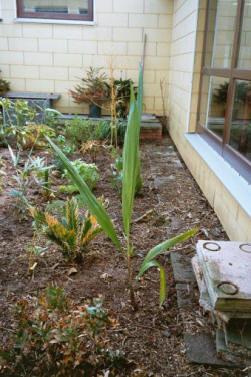
Recently outplanted Syagrus romanzoffiana in
Spring 2005. This species shall be hardy to 18°F
according to the literature. We wonder if it is sea
salt wind resistant and hardy here.
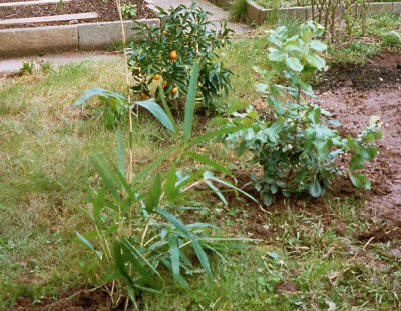
New plantations in one of the atria of James Kruess School in spring, in
the background Fortunella japonica, in the right Metrosideros excelsa and in
the foreground Pseudosasa japonica.
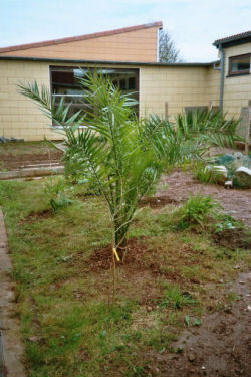
In the background the recently planted 7 feet
tall Phoenix canariensis, in the foreground by the
sea salt wind defoliated Acca sellowiana in Spring
2005.
After the completion of our outplantations we went to the garden of Mr Rickmers. The large Callistemon citrinus also has come through the winter but with the same damages as a specimen in an atrium of the school. Olea europaea was defoliated completely here, an Olea in the pot at the Mielck House which is sheltered from the wind hasn't suffered the slightest damages however. All of the citrus trees have the same damages as the in the atria of the school. The Butia capitata has survived the winter with heavy leaf damages but still lives. I looked also to the Phoenix canariensis which was outdoors already more winters. The same damages. But this palm has shown amazing recovery ablity, also last year was the palm almost dried out and sprouted despite the too cool summer strongly through. The recently outplanted large Phoenix canariensis in the atrium No. 1 of the school will well behave similarly. We don't expect any damages if the next winter doesn't get so windy and the plants could establish themselves.
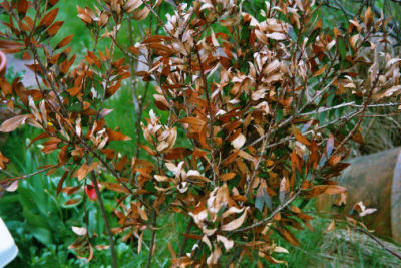
Sea salt wind damages on Callistemon citrinus in the garden of the hotel
"Insulaner".
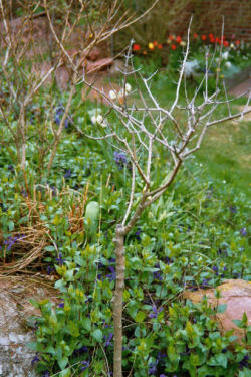
Olea europaea in the garden of the hotel "Insulaner",
completely defoliated by sea salt wind.
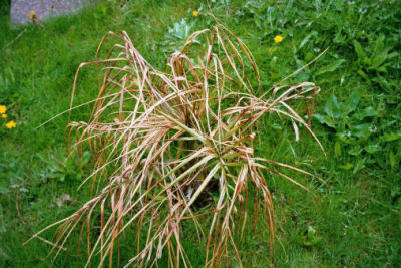
Butia capitata in the garden of the hotel "Insulaner" in Spring 2005,
unfortunately not particulary sea salt wind resistant. Will Juania australis
be better?
The species of bamboo in the garden of the hotel "Insulaner" also showed the same damage picture as this one in the atria of the school, will recover well again. Also Arundo donax 'Variegata', a small Jubaea chilensis, Phormium tenax, Yucca recurvifolia, even the Agave americana var. marginata (which got already before the outplantation a leaf damage), the opuntias of Joerg Witticke and also the Aloe striatula survived the winter. The agave was partly mushy only at older leaves, they otherwise were still all right. The yucca and even the aloe survived undamaged. The opuntias showed only small brown spots, there seems be a fungus attack, they have otherwise suvived. Cupressus arizonica hasn't proved as sea salt wind resistant, also Cupressus sempervirens showed more and less brownings by sea salt wind. Eucalyptus gunnii also has said goodbye well not sea salt wind resistant. But the large Arbutus unedo from Flora Mediterranea has relatively come through the winter well, only relatively little leaf browning. Strawberry trees are also to recommend for mild parts of Germany, they are similarly suitable as Laurus nobilis. Although Pinus canariensis is actually hardy on Heligoland, it hasn't survived the winter, not sea salt wind resistant. Also I saw after the pup of my Musa basjoo 'Sapporo', it has survived the winter! It already showed new growth, but although "down stormed" up to the ground. This without winter protection! Chamaerops humilis also has survived, however Chamaerops humilis var. cerifera hadn't survived. Perhaps Chamaerops humilis var. cerifera is been too small or less sea salt windproof than the unsual species.
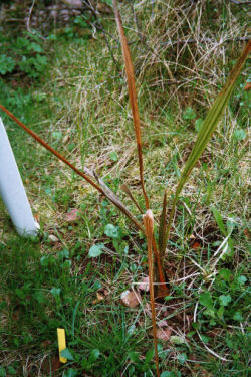
On the quite wind protected place even one
seedling of Jubaea chilensis has survived in the
garden of the hotel "Insulaner" the winter
relative well!
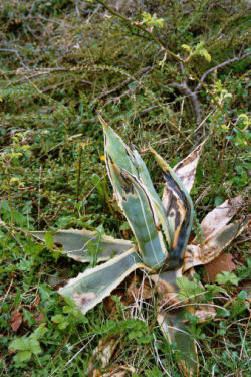
Also Agave americana var. marginata has survived
the winter, without any protection! It will recover
during the summer completely!
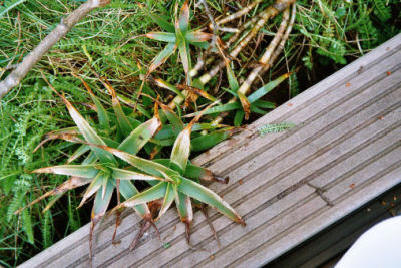
Also Aloe striatula has survived the winter 2004/05 without damages and
also is worth quite sea salt wind tolerant!
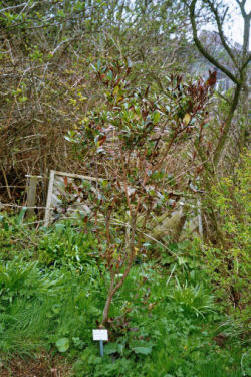
Arbutus unedo in the garden of the hotel
"Insulaner" with quite few sea salt wind
damages, similary suitable like Laurus nobilis
on Heligoland!
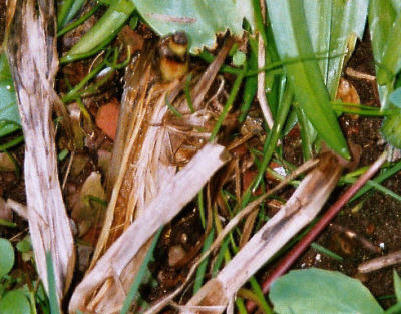
Musa basjoo 'Sapporo' in the garden of the hotel "Insulaner" resprouts
again, has survived the winter without any protection!
I looked after the Canary banana in the tropcial corner of the reading hall of the library, it was well. Unfortunately, we couldn't see after the exotics in the inner courtyard of the Mielck House since in the the inhabitant had gone away for long time but we noticed with being shocked that the both large Quercus ilex at hte Mielck House were defoliated by the many salty storms and the late cold snap at the end of February/the beginning of March, the laurel looked some better, but still leaf brownings. Cinnamomum camphora also looked fairly good in the corner of the Mielck House but also had partial leaf brownings, self the Fatsia japonica also had partial dried up leaf edges. But I saw to the fatsias on Heligoland that they carry even seed. The flowers always freeze to death on the mainland and they develop seed hardly. This is different on Heligoland, they develop seed on the island mostly.
We went also to the cure park where the only yucca from Prof. Dr. Warda stands. The plant still was in good condition. However the swimming pool trachy didn't look very good, most trachys had apparently on Heligoland leaf damages by exceptionally violent sea salt winds and storms. But the palm will recover again, the chances stand well. Against this the trachy behind the monkey puzzle tree and in the bushes still looked quite good, it has come through the exceptionally stormy winter undamaged.
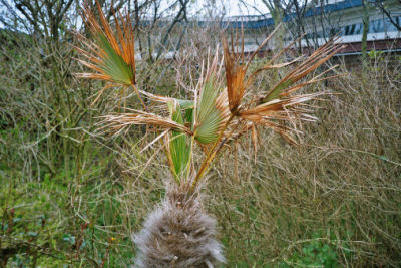
Trachycarpus wagnerianus at the swimming pool on the Northeast Area with
the same damages like at the most trachys on Heligoland.
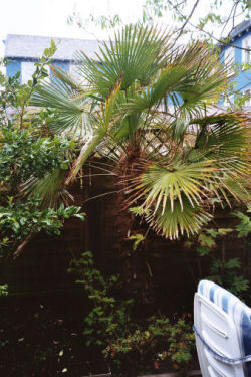
This Trachycarpus fortunei in the Down Town
shows against of that only light sea salt wind
damages, because much more wind sheltered!
The next day we still went to James Kruess School fast to see after the bamboos in the half atrium. All bamboos were defoliated but Phyllostachys bissettii still saw best, partly green leaves at the base. I also took a photo of them to deliver Reinhard Trautmann a hearing of evidence. Also in the half atrium a part of my seedlings from Araucaria angustifolia shall be outplanted next year, I have checked there the possibilities out.
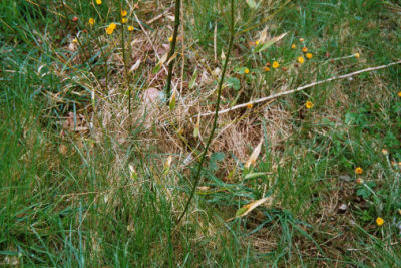
Phyllostachys bissetti seems to have survived the winter better than the
other Phyllostachys species.
We made another round in the Lower Town and discovered even a frontyard where a Cordyline australis, a Trachycarpus fortunei and Chamaerops humilis stand planted out. These plants apparently are from Cordes who sells also "exotics" on the island. I still discovered a Callistemon laevis opposite the frontyard. The plant also had come through the winter, also had the same damages as the other callistemons in an atrium of the school and in the garden of the hotel "Insulaner", but it will recover again. I find always it terrific when somebody has the courage on Heligoland to try it with "exotics", too. We went on and discovered a Cordyline australis bearing fruit in the pot in the receipt of the former Chinese restaurant. We also could harvest seed. Whether the seed germinates is already another question. We went on and passed by the house "Witte Cliff" of the family Pyschny, the Phyllostachys aurea of Tim Pyschny looked relatively good and showed even new shoots! The small trachy of Tim still looked good, too. The oleander looks much less damaged, only relatively little leaf damages. This place apparently is protected very well. I saw an oleander in the pot completely undamaged also in another garden on a terrace which is more deeply put and protected. Whether this was outside also in winter? Best in an immediate house proximity within the Lower Town, oleanders need very well protected places on Heligoland. Whether the recently planted species of Callistemon are better and more sea salt wind resistant, it will prove in the next winters. The Furcraea longaeva 'Variegata' also has proved to be amazily hardy, remained even completely on the bed near the house "Witte Cliff". But this species, related with the agave and the yucca, isn't hardy on the mainland. A specimen in the concrete pail also at the bare has come through the winter well, also at the ferry house "Marina" the 4 copies have come through the winter well. The Chamaerops humilis also have come there through the winter well. Even Cyperus alternifolius seems still to be at the life but killed back to the ground. Whether this plant still sprouts from the roots?
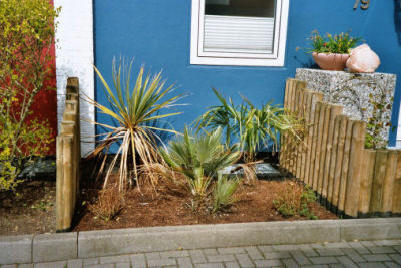
One frontyard in the Lower Town with Cordyline australis, Trachycarpus
fortunei and Chamaerops humilis.
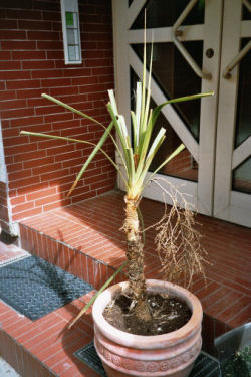
Cordyline australis in pot with seed formation
at the former Chinese restaurant in the Lower
Town.
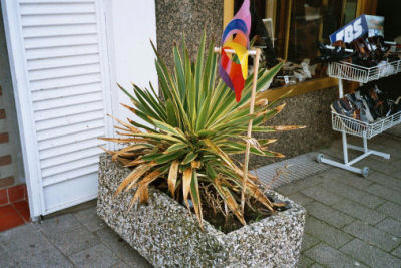
Furcraea longaeva 'Variegata' in a concrete pail in the Lower Town in Spring
2005.
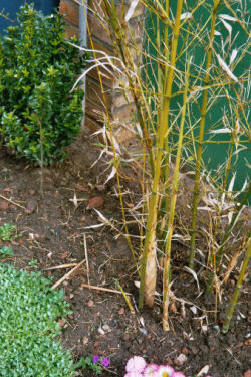
Phyllostachys aurea at the house "Witte Kliff"
with new shoots.
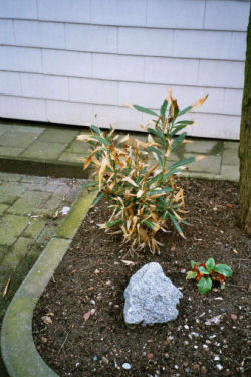
Nerium oleander with only light wind damages
opposited to the house "Witte Kliff", apparently
the place there is wind protected well.
We saw to Phyllostachys bissettii and boryana at the pillars of the hotel "Atoll", these didn't look different from the other ones on the island, but Phyllostachys bissettii got away a little better. Our inspection rounds were completed with that. We have experienced really positive and negative surprises summarized. What still looked promising in October 2004 has partly denied 2004/05, primarily the olives and the citrus trees in winter. As now worth promising are Phormium tenax, Pittosporum tobira, Chamaerops humilis, Arbutus unedo, species of yucca, Cordyline australis and also Aloe striatula. Arundo donax also could have good chances. New Zealandians and also araucarias seem to have the best cards on Heligoland and in the mildest parts of the coastal area of Northern Germany.
We still went to the aquarium. We looked at the sea fauna happening in the North Sea in the aquarium of the Biological Institution. We went back to the Upper Town and collected our baggage. Ulf brought our baggage in the handcart to the catamaran with our thanks to him. We checked in our baggage and said goodbye to Ulf. Wir went by the catamaran to Cuxhaven and further by car with the now empty supporter back to Hamburg.
Later Chris learnt that Ulf has planted one Washingtonia filifera and one Trachycarpus martianus
in the front of his house out.
Photo Gallery About The Inspection And About The Outplantations Spring 2005 (unfortunately only in German,
please click the link on!)
Author: Joachim Jaeck
Updated on August, 8th, 2005